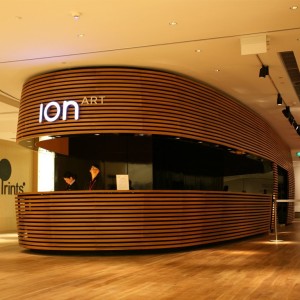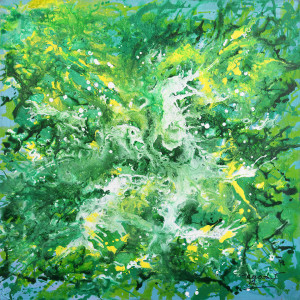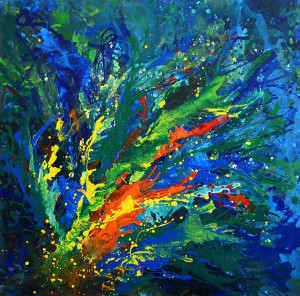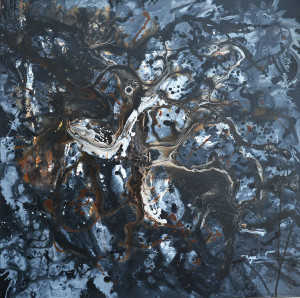■ION Art galleryで開催された個展“Rhythm of The Sea”
シンガポールのショッピングモールION Orchardの4FにION Art galleryがあります。55-56Fの展望台に行くエレベーターに隣接していますので、すぐにわかります。
展望台からの帰りに立ち寄ると、Tran Thi Ngoc Hueさんの個展が開催されていました。会場に入った途端に、鮮やかで奔放な色彩が目に飛び込んできました。個展のタイトルは“Rhythm of The Sea”です。開催期間は6月18日~21日、開催時間は朝11時から夜9時まで、それまでグループ展の多かった彼女にとっては初めての個展です。
Invitation cardに使われていたのが、“Tide”(80cm×80cm, Acrylic on canvas, 2014)です。この作品はカタログの作品紹介ページのトップにも使われていました。きっとお気に入りなのでしょう。緑を基調に構成された色彩の組み合わせと大胆なストロークが弾むような潮の流れを感じさせます。
展示されていたのは2014年から2015年にかけて制作された18点で、すべて海をテーマにした作品でした。Tran Thi Ngoc Hueさんはフーコック(Phu Quoc)島に遊びに行って海を眺め、海と戯れ、海に気持ちを和ませられているうちに、これら一連の作品の着想を得たそうです。
フーコック島はタイランド湾に位置するベトナム最大の島で、近年、リゾート地として開発が進んでいるようです。完全に商業化されているわけではないので、おそらくまだ手つかずの要素がたくさんあるのでしょう。
そこに赴いたTran Thi Ngoc Hueさんはさまざまな海の表情を見て、強く創作意欲を刺激されたのでしょう。海が日々、表情を変えながら奏でるリズムを、荒々しさや快活さ、華やかさといったトーンで抽象的に描き出しています。
たとえば、“Dressing up for ocean night”(80cm×80cm, Acrylic on canvas, 2014)という作品があります。
海の律動的なうねりを見ていると、まるで夜会のためにドレスアップしているように見えたのでしょう。寄せては引き返す波の動きを単なる波動運動と捉えるのではなく、このように擬人化して捉えているところにTran Thi Ngoc Hueさんの感性の幅が感じられます。
私が面白いと思ったのは、“Undertow1”(100cm×100cm, Acrylic on canvas, 2015)です。これまでの作品と違って、色調が暗く、モノトーンの色彩の中に白が効いています。形状はさらに複雑になり流動的で、細部がきめ細かく表現されていて引き込まれます。
実際の海には、どこまでも広がる青い空のような輝かしさだけではなく、ヒトもモノも、時には魂さえも呑み込んでしまう暗さや深さがあるはずです。そのような海の持つネガティブな側面を含めた深淵がこの作品では丁寧に描かれているのです。描き方にもそれまでとは異なる複層性が見られ、惹きつけられました。抽象的な表現の中に海のリアリティが描写されているのが素晴らしいと思いました。
■シンガポールはアジアの現代美術のハブ?
ベトナム人のTran Thi Ngoc Hueさんは画家なのですが、実は、コレクターでもあるようです。彼女は2013年にシンガポールでOrient Paintingという会社を設立しました。世界に向けてベトナムやアジアの現代美術を紹介していくためだといいます。
たしかに、シンガポールはその目的にふさわしい国かもしれません。すでに2000年からシンガポールは巨額の予算を投じて文化政策を重視した政策を展開し、芸術文化のアジアのハブになろうとしてきました。
吉本光宏氏は『ニッセイ基礎研REPORT』(2001年1月)の中で、シンガポールでは情報省から独立した国立芸術評議会(National Art Council)と国立文化財局(National Heritage Board)が中心になって、「シンガポールを情報と芸術のグローバル都市に発展させる」という目的に沿った政策を展開していると指摘しています。
こちら →http://www.nli-research.co.jp/report/report/2000/01/li0101b.pdf
その後の展開を見ると、実際、シンガポール・ビエンナーレ、アート・ステージ・シンガポールなど国際的イベントが定期的に開催されており、美術のハブとしての存在感を高めています。さらに、2010年には最高水準の警備態勢を誇る美術品などの保管施設をチャンギ空港近くにオープンさせています。当時、イギリスのクリスティーズ・インターナショナル・アジア部門の社長フランソワ・クリエル氏は「これをきっかけにシンガポールが香港や北京に匹敵するアジアの美術拠点になる」と予想していたほどです(Bloomberg:2010/05/18)。
シンガポールではこのような美術品取引に対する優遇措置だけではなく、独立50周年を迎えた今年、二つの美術館が誕生します。すでに5月30日、シンガポール・ピナコテーク・ド・パリが開設されておりますし、10月にはナショナル・ギャラリー・シンガポールがオープンします。芸術、美術に関するモノ、情報、ヒトがシンガポールに集まってくる仕掛けが完成しつつあるのです。
シンガポールに拠点を持てば、当然のことながら、世界に認知される確率は高くなるでしょう。そういう点で、Tran Thi Ngoc Hueさんのシンガポール進出は時宜を得たものだといえるかもしれません。アーティストとして自ら輝き、ベトナムやアジアの画家たちを世界に売り出していこうとする彼女の目的に沿った環境がいま、急ピッチで整備されつつあるのです。一連のシンガポールの文化政策を見ていくと、彼女の後に続くヒトは今後、増えていきそうな気がします。(2015/6/22 香取淳子)
この記事については、英語版を添付します。
English version
Ms. Tran Thi Ngoc Hue’s exhibition which I saw in Singapore
■ Solo exhibition “Rhythm of The Sea” was held at ION Art gallery.
ION Art gallery is in the fourth floor of the ION MALL, Singapore. It is next to the elevator to the observatory (55-56F), so you can easily find it.
On the way back from the observatory, I came into ION Art gallery. Tran Thi Ngoc Hue’s solo exhibition had been opened there. As soon as I entered the hall, bright and spirited colors have jumped to the eye. Solo exhibition’s title was “Rhythm of The Sea”. For her it was the first solo exhibition. It was held from 11 am to 9 pm, during June 18- 21.
The Work “Tide” (80cm × 80cm, Acrylic on canvas, 2014) was used in the invitation card and also was used at the first page of the Works catalog. I’m sure it’s her favorite work. In this work I could feel the flow of the bouncy tide, because this picture was expressed by a bold stroke and a configuration of the base color green.
In the hall 18 works produced from 2014 through 2015 were exhibited.
All were the sea themed works. Ms. Tran Thi Ngoc Hue said that she went to Phu Quoc and got the inspiration from the sea. All the works were produced based on that inspiration.
Phu Quoc Island is Vietnam’s largest island located in the Gulf of Thailand. In recent years, it has been developed as a resort. Since not necessarily have been completely commercialized, probably will still have a lot of elements of the untouched.
Tran Thi Ngoc Hue went to Phu Quoc Island and saw various expressions of the sea. These might have stimulated her creative motivation strongly. The rhythms of the tides momently have changed the look of the sea. I thought she was very interested in those rhythms. Based on the rhythm of the tides, she abstractly painted 18 works. Those are painted in harsh touch, in cheerful touch, in pomp touch.
For example, “Dressing up for ocean night” (80cm × 80cm, Acrylic on canvas, 2014)
When looking at the rhythmic swell of the sea, she may have seemed it to have dressed up for the evening. Ms. Tran Thi Ngoc Hue regarded the rhythmic swell of the sea not as mere wave but as the dressed up woman. She abstractly painted this work by technique of anthropomorphic. So I felt her sensibility wonderful.
The work which I felt the most interesting is “Undertow1” (100cm × 100cm, Acrylic on canvas, 2015). Unlike another works, color is dark. But white has been effectively used in the monotone canvas. The shape of the sea in this work is more mysterious and more complicated, than others. In addition, details were drawn in fine-grained representation, so I was attracted.
If we look at the actual sea, perhaps, we might find diverse aspects of the sea. For example, not only the shininess of the sea such as a blue sky spread, but also the darkness and depth of the sea which swallows humans and things, sometimes even souls.
In this painting such a negative aspects were painted carefully. As a result, multi-layer properties that are different from other works could be expressed. In that point I was attracted.
■Is Singapore a Asian contemporary art hub?
Ms. Tran Thi Ngoc Hue is Vietnamese painter and a collector. She founded a company called “Orient Painting” in Singapore in 2013. She said the purpose was to introduce the contemporary art of Vietnam and Asia to the world.
Indeed, Singapore might be suitable country for that purpose. Already Singapore developed the policy with an emphasis on cultural policy to invest a huge amount of budget from 2000, they have been trying to be the Asian hub of arts and culture.
Here →http://www.nli-research.co.jp/report/report/2000/01/li0101b.pdf
In fact, international events, such as Singapore Biennale and Art Stage Singapore, have been held on a regular basis. Singapore has increased the presence of as an art hub.
In addition, Singapore opened the storage facilities with the highest level security for arts, near Changi Airport in 2010.
At the time, President Francois Criel of Christie’s International Asia department said that in the wake of this Singapore would become to be an Asian art hub comparable to Hong Kong and Beijing. (Bloomberg: 2010/05 / 18).
In Singapore, since 2000 the Arts promotion measures have been promoted. Especially preferential policies and international competitions for the Arts have been actively done. As a result, artists, arts goods, and arts information have been gathered in Singapore. Moreover, this year of independence 50th anniversary, two museums are opened.
Already Pinakothek de Paris Singapore was opened in May 30th. The National Gallery Singapore will open in October. This has also enhanced the power of Singapore in arts area.
In the future, I think artists, art goods and art information will accumulate more and more in Singapore. In this way Singapore is preparing for the requirements to become Asia’s art hub.
If you have some arts offices in Singapore, of course, probability of being recognized by the world will be high. From a point of this view, I think Ms. Tran Thi Ngoc Hue’s Singapore foray was very timely. Her purpose is to grow as an artist and to bring Vietnamese and Asian artists on the world market. Now in Singapore, environment for the artists are being developed. So, Singapore is probably the most appropriate city to her purpose. As I look at the series of Singapore’s cultural policy, the people who followed after her, I feel likely to continue to increase. (2015/6/22 Atsuko KATORI)




